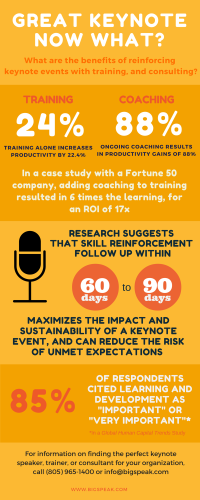Dec 2, 2014
Beyond the Keynote: How to Maximize Your Organization’s ROI with Keynote Speakers After the Conference
By Jonathan Wygant and Ken Sterling
 To implement lasting organizational change, many leaders opt to bring in keynote speakers who speak on topics ranging from productivity to leadership to innovation. Senior executives may walk away from the event feeling confident they know exactly what to do to implement positive change. Unfortunately, those changes hardly ever happen, because the ‘knowing’ of how to do something rarely translates into actually ‘doing.’ This ‘knowing-doing’ gap results in little to no change at all. How do you ‘lock-in-the-learning’ to bridge the ‘knowing-doing’ gap and get the best ROI from your keynote speaker and training dollars?
To implement lasting organizational change, many leaders opt to bring in keynote speakers who speak on topics ranging from productivity to leadership to innovation. Senior executives may walk away from the event feeling confident they know exactly what to do to implement positive change. Unfortunately, those changes hardly ever happen, because the ‘knowing’ of how to do something rarely translates into actually ‘doing.’ This ‘knowing-doing’ gap results in little to no change at all. How do you ‘lock-in-the-learning’ to bridge the ‘knowing-doing’ gap and get the best ROI from your keynote speaker and training dollars?
According to Stanford professor Jeffrey Pfeffer, co-author of The Knowing-Doing Gap, the key is to build a culture of action. In the U.S. alone, $60 billion a year is spent on management training. Additionally, over 80,000 MBA graduates enter the workplace every year, students who presumably have been taught the skills they need to improve the way companies do business. Yet, we still can’t get things done. For corporate culture to improve, we need to take action and make the shift—not just talk about it. In successful companies, there is less of the ‘knowing-doing’ gap. There is much less disparity in these companies between how their teams think, who they are and what they do.
People have a great deal of knowledge, so why aren’t they effective? Because there is no inertia behind the training and because of all the other behavioral inertias already existing within the executive and organization as a whole. People have their own way of working, and they are back to doing what they already know because that’s their comfort zone. Therefore, change does not occur. To be effective, we need to extinguish one behavioral inertia in order to implement a new and better one in its place. To make change permanent, repetition, accountability and tracking are essential best-practices. Consistent training and ongoing coaching are good examples that support the process to ‘lock-in-the-learning.’
While listening to a keynote typically increases productivity by three to five percent over the following six months, productivity has been shown to increase twenty-two percent when further training is provided.
According to Olivero, Bane & Kopelman, adding coaching after training pushes productivity even further to eighty-eight percent.David Rock, co-author of Driving Organizational
Change, concludes that coaching is the key component to improving performance. Rock explains that with a Fortune 50 company, adding coaching to training resulted in executives learning six times as much—with a ROI of 17x. With effective coaching, executives are held accountable to behavioral improvement that results in positive change. Therefore, in addition to bringing in an expert keynote speaker, it’s important to learn how to ‘lock-in-the-learning’ by reinforcing the original message through follow-up workshops, coaching and Internet based learning platforms.
Bridging the ‘knowing-doing’ gap requires deeper immersion in the subject matter and follow-up after the conference is critical. Therefore, be sure to:
- Connect back to the keynote expert to provide additional training via seminar or webinar. A tip to save on fees is to bring in a staff associate as a facilitator of further learning.
- Follow-up keynotes with a same day on-site executive breakout session where participants can roll up their sleeves and work with the subject matter expert on current issues they are facing.
- Using the knowledge gained from the speaker/facilitator, executives should then meet with their team(s) to further implement new best-practices via webinars, weekly check-ins, and slicing the keynote or workshop wisdom gained into five-minute videos that may be viewed on the Internet any time later.
Coaching is an investment in developing your key people for the organization’s long-term benefit. Coupling keynote speakers with follow-up training and coaching leads to knowledge implementation and results in productivity and profitability improvements. Reinforcing the keynote speech with a senior executive team breakout session and following up weekly or quarterly with teleseminars or on-site visits, will go a long way in changing individual and team behavior toward improving the overall corporate culture, performance and profitability.
Tags
